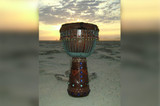Didgeridoo Breathing Technique
Thought of as the world’s oldest instrument, the didgeridoo is not only an icon of Australian culture, but an instrument that has been touted as a health and wellness tool for both the didgeridoo player, as well as those exposed to the unique sound of this instrument. When it comes to the didgeridoo, people are fascinated by the low, droning hum of the instrument and its long shape. More than that, the actual method of circular breathing required to play the didgeridoo captivates even the most seasoned instrument player. Learning this technique takes time, practice, and most importantly, dedication.
To begin circular breathing, it is recommended that the musician first mimic the physical actions needed to simultaneously breathe in and blow out air. Simply puff out the cheeks while breathing in through the nose. This helps the body remember the technique and calls muscle memory into play once the didge player is ready to move to the next step. Once comfortable with this first step, the musician can then push air out of the mouth with the cheeks, sniffing air through the nose to further familiarize the body with the process. This is the basic method of circular breathing that can be further refined by continuing to maintain the steady exhale needed to produce the familiar sound of the didgeridoo. Finally, focus on making this stream of air even stronger, keeping in mind the amount of force needed to properly create the deep, resonating sound of the didgeridoo.
Circular breathing is a technique that is not only challenging to master, but has also been said to create many health and wellness benefits for the musician. From a higher oxygen level in the blood, to the zen-like process of creating and maintaining a steady breathing rhythm, learning circular breathing is not only the required method to play the didgeridoo, but also brings a sense of satisfaction and wellness, the "didgeridoo therapy" effect, to the musician that is rarely felt through playing other percussion instruments.
Recent Posts
-
What is the Best Size Djembe for Beginners?
If you're new to the world of percussion and interested in learning the djembe, you're in for a t …16th Jul 2024 -
The Benefits of Becoming a Drumming Teacher: Transforming Passion into Profession
Why become a drumming teacher? Becoming a drumming teacher is an excellent way to share your pas …22nd May 2024 -
What Makes the Djembe Drum a Spiritual Instrument in African Music?
Origin and history of the Djembe drum The Djembe drum originates from West Africa and holds sign …16th May 2024



